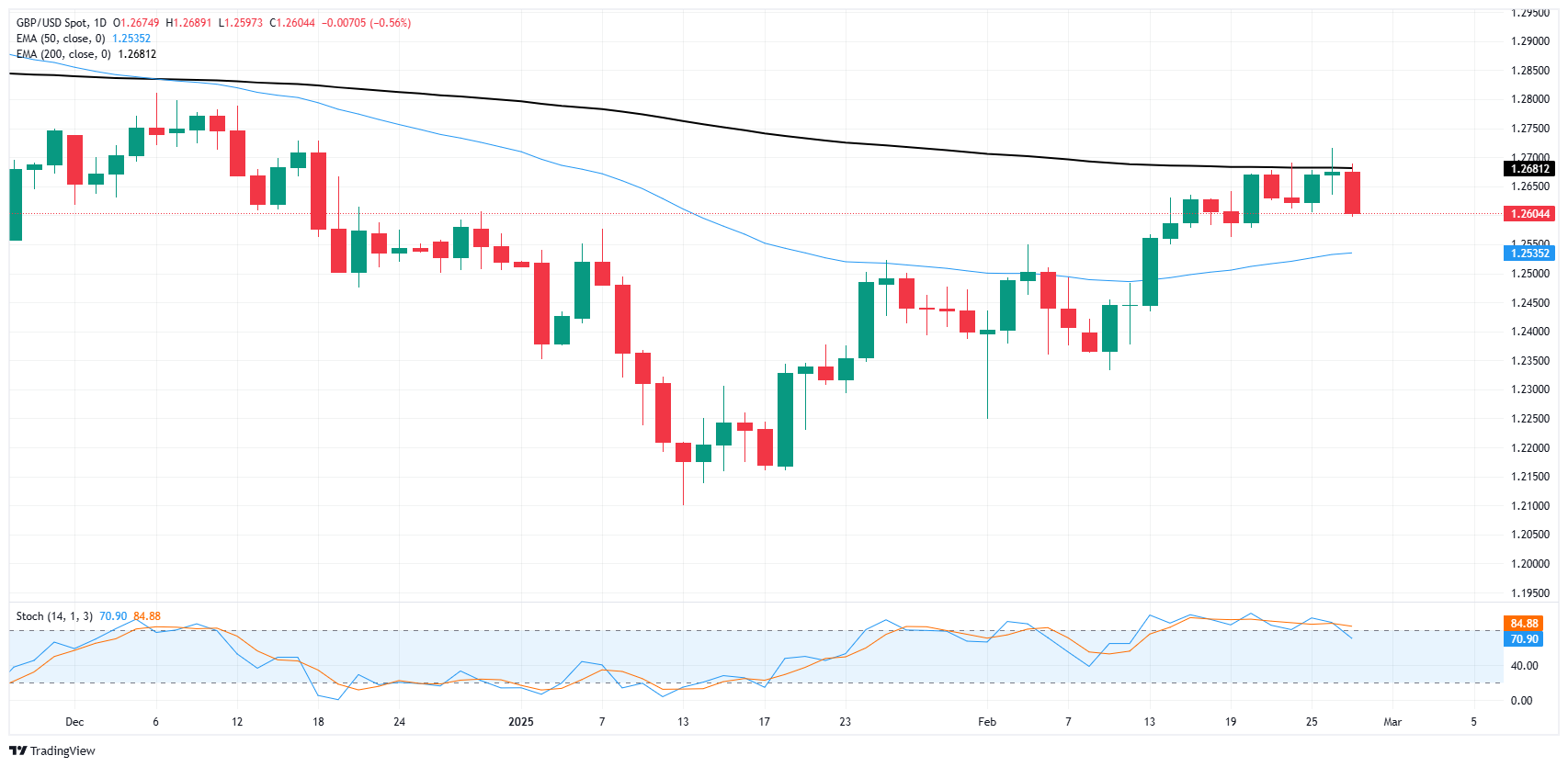GBP/USD tumbles as tariffs on UK come into play
- GBP/USD shed 0.56% on Thursday, falling to 1.2600.
- US President Donald Trump has tabled tariffs on the UK following a meet with PM Starmer.
- US data is tilted to the downside as economic slowdown fears grow.
GBP/USD turned south and tumbled on Thursday, falling nearly six-tenths of a percent and sending bids skidding back into the 1.2600 handle. Risk sentiment is souring after a batch of US data points toward a general lack of strength within the US economy, as well as flagging an extended uptick in core US inflation pressures.
Pound traders can no longer bank on UK avoiding tariff talk
US President Donald Trump met with UK Prime Minister Keir Starmer late Thursday, and President Trump was quick to announce that there might be trade tariffs imposed on the UK as well unless ambiguous terms of a trade deal with the US are reached within an unspecified timeframe. Following on the heels of Donald Trump’s latest pivot on tariffs due on Canada and Mexico, the timing is poor as investors grapple with further geopolitical turmoil on the road ahead.
US Gross Domestic Product (GDP) growth in the fourth quarter exceeded expectations at the beginning of the curve, while Durable Goods spending increased more than anticipated in January. The US GDP rose to 2.4% quarter-over-quarter, surpassing the forecasted 2.2%, although the annualized rate remained stable at 2.3%.
US Durable Goods Orders surged by 3.1% month-over-month in January, exceeding the expected 2.0% and significantly improving from the revised previous figure of -1.8%. While this is a positive sign for economists, there are concerns: a substantial portion of this increase is likely due to businesses stockpiling their inventories in anticipation of potential tariffs, and the recent rise in inflation could be inflating these figures artificially, leading to possible challenges later.
US data headed for another inflation uptick
It’s important to highlight that much of the increase in Durable Goods Orders is attributed to the transportation sector, buoyed by a significant rise in bookings for Boeing (BA) planes and automotive vehicles. Excluding these influences, US Durable Goods Orders remained flat at 0.0% in January, which fell short of the 0.3% forecast and below the revised prior figure of 0.1%.
The US Personal Consumption Expenditure Price Index (PCEPI) inflation report is set to be released on Friday, but the Thursday preview offers bleak prospects for investors hoping that the recent rise in inflation will be short-lived. The quarter-over-quarter Core PCE, serving as a preview for Friday’s primary inflation report, accelerated to 2.7%, up from the anticipated steady figure of 2.5%.
GBP/USD price forecast
GBP/USD’s latest downturn puts price action on the low end of a near-term consolidation pattern baked in just south of the 200-day Exponential Moving Average (EMA) near 1.2680, and short pressure is mounting as technical oscillators roll over in overbought territory. Despite the pair holding firm on the high end of a bullish recovery from the last major swing low into the 1.2100 handle in January, odds are favoring the downside assuming bids are able to crack the 50-day EMA near 1.2535 and head lower.
GBP/USD daily chart
Pound Sterling FAQs
The Pound Sterling (GBP) is the oldest currency in the world (886 AD) and the official currency of the United Kingdom. It is the fourth most traded unit for foreign exchange (FX) in the world, accounting for 12% of all transactions, averaging $630 billion a day, according to 2022 data. Its key trading pairs are GBP/USD, also known as ‘Cable’, which accounts for 11% of FX, GBP/JPY, or the ‘Dragon’ as it is known by traders (3%), and EUR/GBP (2%). The Pound Sterling is issued by the Bank of England (BoE).
The single most important factor influencing the value of the Pound Sterling is monetary policy decided by the Bank of England. The BoE bases its decisions on whether it has achieved its primary goal of “price stability” – a steady inflation rate of around 2%. Its primary tool for achieving this is the adjustment of interest rates. When inflation is too high, the BoE will try to rein it in by raising interest rates, making it more expensive for people and businesses to access credit. This is generally positive for GBP, as higher interest rates make the UK a more attractive place for global investors to park their money. When inflation falls too low it is a sign economic growth is slowing. In this scenario, the BoE will consider lowering interest rates to cheapen credit so businesses will borrow more to invest in growth-generating projects.
Data releases gauge the health of the economy and can impact the value of the Pound Sterling. Indicators such as GDP, Manufacturing and Services PMIs, and employment can all influence the direction of the GBP. A strong economy is good for Sterling. Not only does it attract more foreign investment but it may encourage the BoE to put up interest rates, which will directly strengthen GBP. Otherwise, if economic data is weak, the Pound Sterling is likely to fall.
Another significant data release for the Pound Sterling is the Trade Balance. This indicator measures the difference between what a country earns from its exports and what it spends on imports over a given period. If a country produces highly sought-after exports, its currency will benefit purely from the extra demand created from foreign buyers seeking to purchase these goods. Therefore, a positive net Trade Balance strengthens a currency and vice versa for a negative balance.

